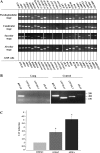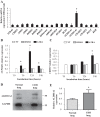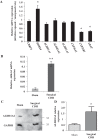Metabolic disturbances of the vitamin A pathway in human diaphragmatic hernia
- PMID: 25416379
- PMCID: PMC4338943
- DOI: 10.1152/ajplung.00108.2014
Metabolic disturbances of the vitamin A pathway in human diaphragmatic hernia
Abstract
Congenital diaphragmatic hernia (CDH) is a common life-threatening congenital anomaly resulting in high rates of perinatal death and neonatal respiratory distress. Some of the nonisolated forms are related to single-gene mutations or genomic rearrangements, but the genetics of the isolated forms (60% of cases) still remains a challenging issue. Retinoid signaling (RA) is critical for both diaphragm and lung development, and it has been hypothesized that subtle disruptions of this pathway could contribute to isolated CDH etiology. Here we used time series of normal and CDH lungs in humans, in nitrofen-exposed rats, and in surgically induced hernia in rabbits to perform a systematic transcriptional analysis of the RA pathway key components. The results point to CRPBP2, CY26B1, and ALDH1A2 as deregulated RA signaling genes in human CDH. Furthermore, the expression profile comparisons suggest that ALDH1A2 overexpression is not a primary event, but rather a consequence of the CDH-induced lung injury. Taken together, these data show that RA signaling disruption is part of CDH pathogenesis, and also that dysregulation of this pathway should be considered organ specifically.
Figures






References
-
- Babiuk RP, Thebaud B, Greer JJ. Reductions in the incidence of nitrofen-induced diaphragmatic hernia by vitamin A and retinoic acid. Am J Physiol Lung Cell Mol Physiol 286: L970–L973, 2004. - PubMed
-
- Beurskens LWJE, Tibboel D, Lindemans J, Duvekot JJ, Cohen-Overbeek TE, Veenma DCM, de Klein A, Greer JJ, Steegers-Theunissen RPM. Retinol status of newborn infants is associated with congenital diaphragmatic hernia. Pediatrics 126: 712–720, 2010. - PubMed
-
- Brady PD, DeKoninck P, Fryns JP, Devriendt K, Deprest JA, Vermeesch JR. Identification of dosage-sensitive genes in fetuses referred with severe isolated congenital diaphragmatic hernia. Prenat Diagn 33: 1283–1292, 2013. - PubMed
-
- Brady PD, Srisupundit K, Devriendt K, Fryns JP, Deprest JA, Vermeesch JR. Recent developments in the genetic factors underlying congenital diaphragmatic hernia. Fetal Diagn Ther 29: 25–39, 2011. - PubMed
-
- Bustin SA, Benes V, Garson JA, Hellemans J, Huggett J, Kubista M, Mueller R, Nolan T, Pfaffl MW, Shipley GL, Vandesompele J, Wittwer CT. The MIQE guidelines: minimum information for publication of quantitative real-time PCR experiments. Clin Chem 55: 611–622, 2009. - PubMed
Publication types
MeSH terms
Substances
LinkOut - more resources
Full Text Sources
Other Literature Sources
Medical

